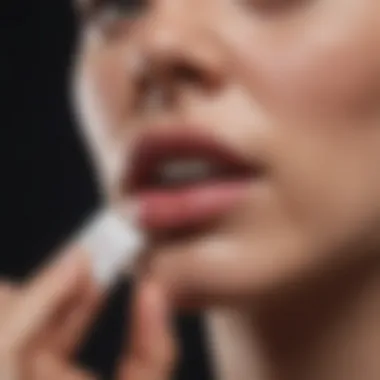Comprehensive Guide to Cold Sore Ointments


Intro
Cold sores, often manifesting as painful blisters around the lips or mouth, are a frequent concern for many. The cause is the herpes simplex virus, which remains dormant in the body before leading to outbreaks triggered by various factors like stress or illness. Understanding the various options for cold sore management, especially ointments, is critical in effectively alleviating discomfort and hastening recovery.
This guide will delve into the mechanisms of cold sore ointments, comparing prescription options with over-the-counter alternatives. It will provide insights into the active ingredients that contribute to their effectiveness, along with application methods that enhance their efficacy. Additionally, we will explore the potential side effects that users should be aware of, creating a comprehensive resource for anyone seeking effective strategies against cold sore outbreaks.
Understanding Cold Sores
Understanding cold sores is crucial for effective management and treatment. Cold sores, often referred to as fever blisters, signify an infection caused primarily by the herpes simplex virus type 1 (HSV-1). This section of the guide will provide essential insights into their nature, triggers, and overall impact on individual well-being.
What Are Cold Sores?
Cold sores manifest as small, painful blisters that typically appear on the lips or around the mouth. These sores are fluid-filled vesicles that develop following an outbreak of the herpes simplex virus.
They often begin with a tingling or burning sensation, heralding their appearance. Once formed, cold sores can be uncomfortable, drawing attention and sometimes leading to social anxiety for those affected. Most people carry the virus for life, as it can become dormant after the initial outbreak, leading to recurrent episodes.
Causes and Triggers
The causes of cold sores primarily tied to the herpes simplex virus. Common triggers include:
- Stress: Emotional or physical stress can weaken immune defenses, paving the way for a breakout.
- Illness: Being sick, especially with conditions that compromise the immune system, can trigger an outbreak.
- Sun Exposure: Prolonged sunlight without protection can increase susceptibility to cold sores because UV radiation damages skin and immune function.
- Hormonal Changes: Fluctuations during menstrual cycles or pregnancy can also initiate outbreaks.
- Injury to Skin: Cuts or abrasions around the mouth can introduce the virus to fresh tissue, resulting in cold sores.
Understanding these factors helps in identifying personal triggers, which is vital for prevention and timely management of outbreaks.
According to the Centers for Disease Control and Prevention, nearly 50% to 80% of adults in the United States carry HSV-1, highlighting the widespread nature of the virus.
Recognizing the significance of cold sore outbreaks leads to a better approach for sufferers. It allows for informed choices regarding ointments and treatment methods, thus easing the discomfort they bring.
The Role of Ointments in Treatment
Cold sore ointments play a vital role in the management of herpes simplex virus outbreaks. This category of topical treatments serves as a primary line of defense against the discomfort and unsightliness that accompany cold sores. Ointments are designed to alleviate symptoms, speed up recovery, and inhibit virus progression. By applying these products directly to affected areas, individuals can mitigate pain and lessen the duration of outbreaks.
Several ointments contain antiviral ingredients that work effectively against the herpes virus. This direct application allows for higher concentrations of active ingredients at the site of infection, which is a significant advantage in treatment. Moreover, many of these ointments include soothing agents that provide immediate relief from burning or itching sensations. This combination of antiviral action and symptomatic relief underscores the value of ointments in therapeutic contexts.
When choosing an ointment, factors such as efficacy, side effects, and application frequency become crucial. Understanding the physiological role these ointments play can inform better treatment decisions. This insight is particularly important for health professionals and wellness coaches who guide clients in managing outbreaks.
How Ointments Function
Ointments designed for cold sores function primarily through their active ingredients. Advances in topical formulations have led to various mechanisms that target the herpes simplex virus effectively. Common ingredients, such as acyclovir, interfere with viral replication. This interruption slows the spread of the virus and boosts healing.
In addition to antivirals, some ointments contain moisturizers and emollients. These ingredients may appear basic, but they serve an essential role in preventing skin from cracking, which can invite secondary infections. By maintaining skin barrier integrity, these ointments not only alleviate symptoms but also promote a healthier healing environment.
Benefits of Topical Treatments
Topical treatments, specifically cold sore ointments, provide numerous advantages that enhance overall treatment strategies. The main benefits include:
- Localized Treatment: Ointments can be applied directly to the infected area, maximizing the concentration of active ingredients where they are most needed.
- Rapid Relief: Many formulations include soothing components, providing quick relief from symptoms such as pain and irritation.
- User Control: Patients have the ability to apply the treatment at their convenience, making it easier to integrate into daily routines.
Moreover, studies indicate that when ointments are used at the first signs of an outbreak, their effectiveness increases significantly. Therefore, recognizing early symptoms and timely application is essential for optimal results.
"The key to effective cold sore management lies in immediate action and informed choices regarding ointments."
In summary, the role of ointments in treating cold sores is multi-faceted. They not only function to inhibit viral progression but also provide symptomatic relief. Understanding these aspects is essential for health professionals guiding patients through management strategies.
Types of Cold Sore Ointments
Understanding the various types of cold sore ointments is essential for effective management of outbreaks. Each category of ointment provides distinct advantages, which caters to different user needs and preferences. This section discusses over-the-counter options, prescription ointments, and natural remedies. Knowing these alternatives can help individuals to choose the most suitable treatment for their condition.
Over-the-Counter Options


Over-the-counter (OTC) ointments are widely available and can be purchased without a prescription. These products typically contain antiviral agents that aim to reduce healing time and alleviate pain. Common ingredients in OTC ointments include docosanol and benzocaine.
Benefits of using OTC options include:
- Accessibility: They can be found in pharmacies or online.
- Cost-effectiveness: Generally more affordable than prescription treatments.
- Ease of use: Most products come with straightforward application instructions.
However, while they can be effective for mild outbreaks, severe or recurrent cases may require more potent prescription options.
Prescription Ointments
Prescription ointments are designed for cases where over-the-counter solutions are insufficient. These ointments often contain higher concentrations of active ingredients, such as acyclovir. Acyclovir is a powerful antiviral that can speed up healing, reduce pain, and inhibit the virus from replicating.
Considerations when using prescription ointments:
- They are typically recommended for recurrent or severe outbreaks.
- A consultation with a healthcare provider is necessary to obtain these medications.
- They may come with higher costs and potential insurance complications.
Individuals with frequent outbreaks may find these ointments more effective than their OTC counterparts.
Natural Remedies
Natural remedies for cold sores may appeal to those seeking alternative treatment methods. Options such as L-lysine supplements and topical applications derived from natural ingredients like tea tree oil and aloe vera are common. While these remedies lack the extensive clinical backing seen with pharmaceutical options, some users report positive effects.
Pros of using natural remedies include:
- Fewer side effects: Many people prefer gentler treatments.
- Holistic approach: These options often focus on overall wellness rather than just symptom relief.
It’s important, however, for individuals to be cautious. Natural does not always mean safer, and efficacy may vary significantly among different people.
Key Ingredients in Cold Sore Ointments
Understanding the key ingredients in cold sore ointments is crucial for effective treatment. Each ingredient carries its unique properties and benefits, influencing the ointment’s efficacy in managing herpes simplex virus outbreaks. By recognizing these ingredients, you can make informed choices about which ointment may work best in your situation.
Acyclovir
Acyclovir is an antiviral medication commonly used in the treatment of cold sores. This ingredient works by inhibiting the replication of the herpes virus, thus reducing the duration of outbreaks. Acyclovir is most effective when applied at the first sign of a cold sore, allowing it to penetrate the affected area swiftly. Those suffering from frequent breakouts may benefit from its prescription form, which can provide a more concentrated effect.
Some important points about Acyclovir include:
- Speed of Action: Its early application is key; it helps in minimizing sore severity.
- Application Frequency: Depending on the formulation, it may require several applications daily for maximum effect.
- Side Effects: Common side effects may include local irritation or dryness. It is suggested to monitor for any unusual reactions.
Docosanol
Docosanol is another notable ingredient, recognized for its unique approach to cold sore management. Instead of targeting the virus directly, docosanol works by preventing the virus from entering healthy skin cells. This mechanism not only helps to speed up healing but can also reduce the spread of the virus to other areas, making it an effective option for those dealing with cold sores.
Key aspects of Docosanol:
- Mechanism: It creates a protective barrier to lessen the likelihood of virus entry during a breakout.
- User-Friendly: Available over the counter, making it accessible for quick use.
- Time of Application: Users are encouraged to apply it at the onset of symptoms for optimal results.
L-lysine
L-lysine is an essential amino acid that has gained attention for its potential role in cold sore treatment. It is thought to inhibit the replication of the herpes virus, which could help reduce the frequency and severity of outbreaks when taken as a supplement. L-lysine may not be present in all topical ointments, but some combinations include it as an adjunct to other ingredients.
Highlights of L-lysine’s benefits:
- Natural Remedy: Known to support immune function, it may play a role in preventing outbreaks.
- Supplemental Use: Often taken orally, many users report fewer breakouts with regular use.
- Complementary Action: Typically used alongside other active ingredients for a holistic approach.
When choosing a cold sore ointment, understanding these key ingredients can empower users to select the most suitable treatment options.
In summary, the effectiveness of cold sore ointments heavily relies on their key ingredients. Acyclovir, Docosanol, and L-lysine each play distinct roles in managing symptoms and promoting healing. Knowing these components allows for smarter choices in mitigation and prevention of cold sores.


Application Techniques
The application techniques of cold sore ointments are critical in ensuring optimal effectiveness. Proper application not only enhances the absorption of the medication but also minimizes the risk of spreading the virus to other areas. Understanding when and how to apply these treatments can significantly impact recovery time and overall symptom management.
When to Apply Ointments
Recognizing the right timing for the application of cold sore ointments plays a pivotal role in successful treatment. It is advisable to start using ointments at the first sign of an outbreak. Symptoms may include tingling, itching, or a burning sensation before the blister appears. Applying treatment at this stage can help limit the severity and duration of the outbreak.
Additionally, applying the ointment frequently throughout the day can aid in maintaining moisture on the affected area. This is especially pertinent during the blistering and crusting phases, where dryness can worsen discomfort. Prospective users should refer to specific product instructions to determine the frequency of application, as this can vary from one ointment to another.
How to Apply Effectively
For effective application of cold sore ointments, certain techniques should be observed. Firstly, washing your hands thoroughly before touching the ointment or applying it to the affected area is essential. This helps prevent infection and avoids any contamination of the ointment itself.
When applying the ointment, use a clean cotton swab or your fingertip to gently dab the ointment directly onto the sore. It is crucial not to rub the ointment vigorously, as this may irritate the skin further. Spread the ointment evenly, ensuring a light coating over the entire cold sore.
After applying, wash your hands again to prevent the virus from spreading to other areas of your body or to others. If blisters or sores are present, avoidance of any touching is key. Monitoring the sore's condition and adjusting application frequency as needed can help enhance recovery.
Key Points:
- Apply ointment at the earliest signs of an outbreak.
- Maintain cleanliness of hands and application tools.
- Use gentle dabbing motions rather than rubbing.
By following these techniques, individuals can improve the chances of limiting the duration of their cold sore outbreaks and managing symptoms more effectively.
Potential Side Effects
Understanding the potential side effects of cold sore ointments is crucial for informed decision-making. While these products are designed to alleviate symptoms, users may experience varying reactions. Therefore, awareness of both common and severe side effects can help manage expectations and encourage appropriate usage.
Common Reactions
Many individuals report mild side effects when using cold sore ointments. These might include:
- Skin irritation: Users might notice a slight burning or stinging sensation upon application.
- Redness: The affected area may become red, signaling an irritation response.
- Dryness or peeling: As ointments work to hydrate and heal, some users might experience dryness or flaking of skin.
These reactions are typically temporary and subside as skin acclimatizes to the product. However, if these symptoms persist or worsen, it is essential to reconsider the product's suitability.
Severe Adverse Effects
In rare cases, severe side effects may occur. While the likelihood is lower, they merit attention. Possible severe reactions include:
- Allergic reactions: These can manifest as hives, swelling of the face or throat, and breathing difficulties, necessitating immediate medical assistance.
- Severe skin reactions: Signs may include blistering, severe rash, or extensive peeling that might require cessation of product use.
It is crucial for individuals to monitor their body’s responses closely. Reporting severe effects to a healthcare professional can provide insights into safer alternatives and contribute to better guidelines in product applications.
Always consult with a healthcare provider if unsure about symptoms or side effects to ensure safe and proper usage of cold sore ointments.
Choosing the Right Ointment
Selecting an appropriate cold sore ointment is critical for effective treatment. The right choice can significantly impact symptom management, speed of recovery, and overall comfort. There are many factors to consider when choosing an ointment to ensure it aligns with individual needs and specific scenarios.
Factors to Consider
When evaluating which ointment to use for cold sore management, several key aspects should be taken into account:
- Type of Sore: Identify whether the cold sore is in its early stage or a fully developed sore. Some ointments work better for specific stages of cold sore development.
- Active Ingredients: Common ingredients like Acyclovir and Docosanol offer varying effectiveness. Researching these components helps in making an informed choice.
- Skin Sensitivity: Each person's skin reacts differently. Those with sensitive skin may need to avoid certain harsh ingredients to prevent irritation.
- Onset of Symptoms: Timing is crucial. If symptoms are noticed early, certain ointments may provide better results. Knowing when to apply is just as important as the choice of product.
- Formulation: There are different formulations available including creams, gels, and ointments. Reviewing each form for absorbance and consistency can be beneficial for application comfort.
- Cost and Accessibility: Over-the-counter options are often more affordable and accessible compared to prescription ointments. Consider the healthcare policies if choosing a prescription ointment.
Consulting Healthcare Professionals
Seeking advice from healthcare professionals can guide individuals toward the most suitable cold sore treatment options. Here are a few reasons why consulting a medical expert is valuable:


- Personalized Recommendations: Each case of cold sores can vary in severity and trigger factors. Healthcare professionals can recommend specific ointments based on personal history and symptoms.
- Monitoring Medication Interactions: Some people may be on other medications that could interact with cold sore treatments. Professionals can provide insight into potential risks and address concerns.
- Understanding Side Effects: Comprehensive knowledge of potential side effects of certain ingredients can help in decision-making. Healthcare professionals can help identify safe options tailored to individual health conditions.
- Information on New Treatments: They can also introduce you to emerging treatments or research that might not be widely known. Staying informed about advancements can lead to better long-term management of outbreaks.
- Recommendation for Further Testing: In some cases, it may be necessary to conduct tests to rule out other skin conditions. Professional evaluations can ensure appropriate treatment protocols are followed.
Preventive Measures
Preventive measures play a critical role in managing cold sores and minimizing outbreaks. Understanding how to avoid triggers and implement certain changes can be beneficial for individuals prone to the herpes simplex virus. This section will explore specific lifestyle adjustments and recurrence patterns that contribute to effective prevention strategies.
Lifestyle Adjustments
Adopting certain lifestyle adjustments can significantly lower the frequency of cold sore outbreaks. Some important changes to consider include:
- Sun Protection: Exposure to UV rays can trigger cold sores. Using lip balm with SPF or wearing a wide-brimmed hat during sun exposure can protect the lips.
- Stress Management: Stress is a known trigger for outbreaks. Engaging in relaxation techniques such as yoga, meditation, or even regular exercise can help manage stress levels effectively.
- Dietary Considerations: A well-balanced diet supports overall health and immunity. Foods rich in vitamins and minerals can aid in preventing outbreaks. For example, incorporating foods high in L-lysine, such as dairy products, may reduce the frequency of cold sores. Avoiding excessive intake of arginine-rich foods, like nuts and chocolate, may also be beneficial.
- Hygiene Practices: Maintaining good hygiene is vital in preventing the spread of the herpes simplex virus. Washing hands frequently and avoiding direct contact with sores can minimize transmission.
Implementing these adjustments not only aids in preventing outbreaks but also enhances overall health, forming a solid foundation for other preventive methods.
Understanding Recurrence Patterns
Recognizing recurrence patterns is vital for individuals prone to cold sores. Many people experience outbreaks in cycles, often after triggering events. Here are key points to consider:
- Identify Personal Triggers: Each individual may have unique triggers, such as stress, illness, or hormonal changes. Keeping a symptom diary can help identify these specific patterns.
- Frequency of Outbreaks: Some individuals experience frequent cold sores, while others may have one or two outbreaks a year. Understanding personal frequency can aid in implementing preventive strategies more effectively.
- Timing and Duration: Cold sores typically develop in stages: tingling, blistering, crusting, and healing. Knowing the typical timeline can help in early intervention, which may involve the use of topical ointments.
- Environmental Factors: External factors like extreme weather, allergens, and illness can contribute to outbreaks. Being aware of these influences can guide adjustments in lifestyle and overall preparedness.
By understanding personal recurrence patterns, individuals can take proactive measures to mitigate their impact, leading to fewer episodes and less distress associated with cold sores.
The Future of Cold Sore Treatments
The evolving landscape of medical research and treatment modalities for cold sores signifies a pivotal shift in managing this pervasive condition. Understanding the future of cold sore treatments is essential for several reasons. As we advance in technology and healthcare, novel therapies emerge that may not only improve the efficacy of existing remedies but also minimize side effects associated with traditional treatments.
This section presents an analysis of two significant areas: innovative research and development, as well as emerging treatments tailored to combat cold sores efficiently. By staying abreast of these advancements, health professionals, wellness coaches, and nutritionists can equip themselves with up-to-date knowledge that enhances their practices.
Innovative Research and Development
Modern research initiatives are redefining the way cold sores are treated. Scientists examine various mechanisms that the herpes simplex virus employs to evade the immune system. These insights are critical.
Recent studies explore novel antiviral agents that can specifically target viral replication without harming healthy cells. One promising avenue includes the development of CRISPR technology, which targets and cuts viral DNA within human cells. This approach could potentially lead to a more permanent solution by preventing the virus from reactivating after its initial infection.
Additionally, researchers investigate monoclonal antibodies, which can provide a strong immune response against the virus, even after reactivation. The potential for such targeted therapies to complement existing treatments is significant, potentially limiting the number and severity of outbreaks.
Innovative approaches help us reimagine the treatment landscape, moving beyond the standard topical ointments.
Emerging Treatments
The preparation of future treatments is also promising with various innovations on the horizon. Among emerging therapies, oral medications capable of reducing the duration and intensity of outbreaks are gaining traction. For example, Valacyclovir has shown effectiveness and could soon have enhanced formulations that are better absorbed. This would facilitate quicker responses to outbreaks.
Another area of focus includes vaccine research. Efforts are ongoing to create a preventive vaccine against the herpes simplex virus, which could dramatically reduce infection rates. The feasibility of a therapeutic vaccine, aimed at those already infected, remains an active field of study. Such a vaccine could address the root cause of recurrence, thus reducing or eliminating future outbreaks.
Other alternatives include phytochemicals and nutritional supplements, designed not only to alleviate symptoms but also to boost overall immune response. For instance, research into botanical extracts suggests that they may inhibit the virus’s growth or help shorten outbreaks when combined with conventional treatments. These developments provide a broader set of options for patients and healthcare providers alike.
End
In concluding this comprehensive guide, the significance of understanding cold sore ointments cannot be overstated. Cold sores, primarily caused by the herpes simplex virus, affect many individuals and can impact daily life. The knowledge gathered here helps demystify the options available in managing these outbreaks effectively.
Key Takeaways
The core elements of this article shed light on essential aspects of cold sore treatment. Key points include:
- Mechanisms of Action: Understanding how specific ingredients like Acyclovir and Docosanol function can aid users in making informed decisions about their treatment choices.
- Application Techniques: Knowing the right techniques for application ensures that ointments are used effectively, maximizing their potential benefits.
- Potential Side Effects: Awareness of side effects allows users to manage their expectations. It's crucial to recognize that reactions vary from person to person.
- Choosing the Right Ointment: Factors to consider when selecting an ointment are diverse and include severity of symptoms, past reactions, and personal health conditions.
Importance of Timely Management
Timely intervention, as outlined in this guide, is key to alleviating symptoms and can reduce the duration of an outbreak. A proactive approach in applying ointments at the onset of symptoms provides a notable advantage in handling cold sore outbreaks.
Considerations for Health Professionals
For health professionals, being well-versed in cold sore treatments can enhance patient care. Educating patients about the nuances of different ointments, their active components, and the safe application can foster better management of their condition.
This comprehensive guide serves as a vital resource for making informed decisions regarding cold sore treatment and management. The insights provided here form a foundation for individuals to tackle cold sores with confidence, utilizing both over-the-counter and prescription options to find the most suitable relief for their needs.



